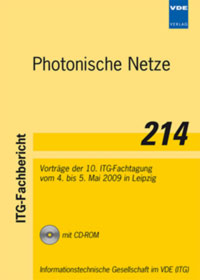Low-energy demarcation device for monitoring FTTx networks
Conference: Photonische Netze - 10. ITG-Fachtagung
05/04/2009 - 05/05/2009 at Leipzig, Germany
Proceedings: Photonische Netze
Pages: 3Language: englishTyp: PDF
Personal VDE Members are entitled to a 10% discount on this title
Authors:
Röger, Moritz; Hoh, Matthias; Leuthold, Juerg; Freude, Wolfgang (Institute of Photonics and Quantum Electronics, University of Karlsruhe, Germany)
Hehmann, Joerg; Pfeiffer, Thomas (Alcatel-Lucent, Bell Labs Germany, Stuttgart, Germany)
Huebner, Michael; Becker, Juergen (Institute of Information Processing Technology, University of Karlsruhe, Germany)
Abstract:
In a passive optical network, network availability as well as network security will become increasingly important. Traffic-transparent energy-autarkic supervision units located at demarcation points between network segments (so-called demarcation devices, DD) would fill this need. The DD respond to a low-duty cycle low-bitrate control signal which the operator’s central office (CO) superimposes to the optical data stream sent to the subscribers. Most of the time the DD stay in a low-energy sleep mode, but awake during very short time intervals for communicating with the CO. In sleep mode, synchronism with the CO is lost. Our new low-energy medium-access control (LE-MAC) protocol assures a fixed “rendezvous” time where all DD can individually respond to the CO. In a small network we show the feasibility of the concept and the functionality of the LE-MAC protocol. The mean current consumption of a DD is less than 1 muA corresponding to 3 muW. With a single inexpensive lithium ion battery, such a DD could operate for more than 10 years.


